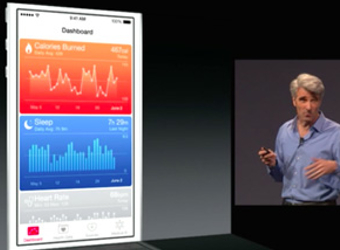Apple enters ‘quantified self’ and ‘connected home’ spheres on raft of software updates
Share

Apple held the keynote presentation of its Worldwide Developer Conference (WWDC) this morning (AEST), the annual conference at which Apple typically reveals the new versions of its software platforms, rather than new hardware.
Some of the most interesting updates in this year’s announcements are hidden away in the plumbing, the new frameworks made available for developers. These include ‘HealthKit,’ which provides the ability for health and fitness apps to communicate with each other, and ‘HomeKit,’ which delivers a common protocol, secure pairing and the ability to control individual or groups of devices throughout the house, such as lights, and includes integration with Siri.
If you’re after some hearty discussion of the new operating systems and developer tools Apple announced, we recommend our sister publication MacWorld Australia and site MacTalk.
But, if you just want to scan over the announced changes to Apple’s operating systems and apps then look no further than this very page. (We’ve tried to remove all the superlatives.) This post is a summary of:
- Apple unveils iOS 8 – “the biggest release since the launch of the App Store,”
- Apple announces OS X Yosemite, and
- Apple releases iOS 8 SDK with more than 4000 new APIs.
1. Apple unveils iOS 8 – “the biggest release since the launch of the App Store”
“Introduces iCloud Photo Library, new messages features and new health app.”
Apple is calling iOS 8 “the biggest release since the launch of the App Store”. iOS 8 delivers a “simpler, faster and more intuitive” user experience, including iCloud Photo Library, new Messages features to easily share voice, video or photos with just a swipe, and an entirely new health app that gives you a clear overview of your health and fitness data all in one place. iOS 8 also includes predictive typing for Apple’s QuickType keyboard, Family Sharing, a system for sharing purchases, photos and calendars within the same household, and iCloud Drive, for storing files and accessing them from anywhere.
Additional iOS 8 features include:
- Design enhancements that build off the stunning interface of iOS 7, bringing interactive notifications, quick access to key contacts, the ability to quickly switch back and forth between the inbox and drafts in Mail, as well as intelligent suggestions.
- extended Spotlight capabilities that give you results beyond what’s on your device, including articles from Wikipedia, findings from the news and results from places nearby.
- greater continuity between iPhone, iPad and Mac, including Handoff to start an activity on one device and finish on another, along with Instant Hotspot and the ability to make and receive calls and send SMS and MMS messages from your Mac or iPad.
2. Apple announces OS X Yosemite
“Introduces refined new design, powerful apps and amazing new continuity features.”
The new version of Apple’s desktop operating system is called OS X Yosemite, which is “redesigned and refined with a fresh, modern look, powerful new apps and amazing new continuity features.”
The new Today view in Notification Centre gives a quick look at everything you need to know all in one place, iCloud Drive is located within the Finder and can store files of any type, and Safari has a new streamlined design. Mail makes editing and sending attachments easier than ever, Handoff lets you start an activity on one device and pass it to the other, and Instant Hotspot makes using your iPhone’s hotspot as easy as connecting to a Wi-Fi network. Yosemite also gives you the ability to make iPhone calls on your Mac.
3. Apple releases iOS 8 SDK with more than 4000 new APIs
“Biggest developer release ever includes extensibility features, HealthKit, HomeKit and Swift.”
Apple today released its iOS 8 SDK, the biggest developer release ever with more than 4000 new APIs. iOS 8 allows developers to further customise the user experience with major extensibility features like Notification Centre widgets and third-party keyboards; and introduces robust frameworks such as HealthKit and HomeKit. iOS 8 also includes Metal, a new graphics technology that maximises the performance of the A7 chip and Swift, a powerful new programming language.
iOS 8 brings:
- HealthKit APIs that provide the ability for health and fitness apps to communicate with each other.
- iOS extensions, including new sharing options, custom photo filters, custom actions and document APIs. Developers can now add their own widgets into Notification Centre, and third-party keyboards offer additional layouts and input methods.
- Metal, is a new graphics technology that maximises performance on the A7 chip that will improve the quality of games.
- Swift is a new programming language for iOS and OS X that makes it easier than ever for developers to create apps.
- Touch ID APIs enable developers to securely authenticate users within apps, protect logins and user data, and unlock keychain items.
- PhotoKit, so developers can tap into the power of the same robust framework as the built-in Photos app for faster performance, nondestructive edits and the ability to both read and write to the Photos library.
- New Camera APIs, giving developers fine grain control over focus, white balance and exposure.
- CloudKit, a complete and scaleable back-end solution helps developers eliminate the need for writing server code and maintaining servers.
- New App Store features for developers like app previews and app bundles, the new iTunes Connect with free analytics and TestFlight for beta testing pre-release apps.














